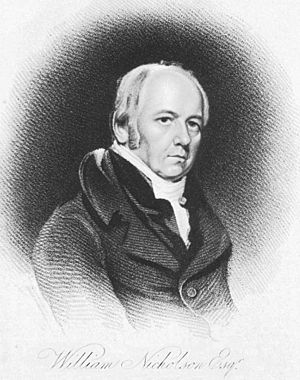William Nicholson (chemist) facts for kids
William Nicholson (born December 13, 1753 – died May 21, 1815) was a very talented English person. He was a writer, a translator, a publisher, and a scientist. He also invented things and worked as an engineer.
In 1797, he started Britain's first monthly science magazine. It was called Journal of Natural Philosophy, Chemistry, and the Arts. He was its editor until 1814. In 1800, he and Anthony Carlisle made an amazing discovery. They were the first to split water into hydrogen and oxygen gas. They did this using a special battery called a voltaic pile. This process is known as electrolysis. Nicholson also wrote many books about science and chemistry.
Early Life and Adventures
William Nicholson grew up and went to school in Yorkshire, England. After finishing school, he joined the British East India Company. He worked as a midshipman, which is a junior officer on a ship. He traveled on two long voyages. His first trip was to India. His second trip was to China on a ship called the Gatton between 1772 and 1773.
Later, in 1775, he met a famous potter named Josiah Wedgwood. Nicholson then moved to Amsterdam in the Netherlands. He worked there for a few years as Wedgwood's agent, helping to sell his pottery.
When he came back to England, a writer named Thomas Holcroft convinced him to write. Nicholson started writing light stories for magazines. He also helped Holcroft with his plays and novels, like Alwyn and Duplicity.
At the same time, Nicholson was busy writing his own science book. It was called An Introduction to Natural Philosophy. This book was published in 1782 and became very popular right away. He also translated books for his publisher, Joseph Johnson. These included Voltaire's Elements of the Philosophy of Newton and a history book about Hyder Shah. After his travels, he wrote The Navigator’s Assistant. This book shared what he learned from his time with the East India Company.
In 1784, Josiah Wedgwood, who was in charge of a group called the General Chamber of Manufacturers of Great Britain, suggested Nicholson for a job. Nicholson became the secretary for this important group. He also worked with the Society for the Encouragement of Naval Architecture, which started in 1791. This group helped improve ship design.
Amazing Scientific Discoveries
On December 12, 1783, William Nicholson joined a science club. It was called the "Chapter Coffee House Philosophical Society." He was suggested by Jean-Hyacinthe Magellan.
In 1789, Nicholson shared two papers about electricity with the Royal Society. He also looked into a debate about a theory called phlogiston. He translated comments from French scientists about it.
In 1784, he invented the Nicholson hydrometer. This tool helps measure how dense liquids or solids are. It has a pan on top for small weights. It also has a small basket on the bottom to hold a sample.
In 1790, William Nicholson received a patent for a new printing machine. It was a cylindrical design, meaning it used a rotating cylinder. This design was later copied in other countries. It helped pave the way for modern printing presses.
In 1797, he started his own science magazine. It was called Journal of Natural Philosophy, Chemistry and the Arts. People often called it Nicholson's Journal. It was the first monthly science magazine of its kind in Britain. This journal published important early ideas about how gliders fly. These ideas came from George Cayley in 1809–1810. The magazine continued to be published until 1814.
In 1799, Nicholson opened a school in London's Soho Square. There, he taught natural philosophy (which is like physics) and chemistry. He received money from Thomas Pitt to help start the school.
In May 1800, he and Anthony Carlisle made a huge discovery. They used a Voltaic pile (an early battery) to split water. This process, called electrolysis, separated water into hydrogen and oxygen gas. This was a very important step in understanding chemistry and electricity. Because of their work, they were asked to join a special committee. This committee was part of the new Royal Institution.
Nicholson also wrote many other scientific books. He translated books on chemistry by Fourcroy and Chaptal. He wrote First Principles of Chemistry (1788) and a Chemical Dictionary (1795). He also helped edit a large encyclopedia called the British Encyclopedia, or Dictionary of Arts and Sciences.
Later Life and Legacy
In his later years, William Nicholson focused on engineering projects. He worked on water supply systems. He helped bring water to towns like Portsmouth, Gosport, and Hammersmith.
William Nicholson passed away in Bloomsbury, London, on May 21, 1815. He was 61 years old. His friend Sir Anthony Carlisle was with him. Nicholson's work in science, publishing, and engineering left a lasting impact.
See also
- Timeline of hydrogen technologies



